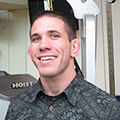"Where do I start? What do I read first? Where should I focus my attention? How much time should I allocate to my studies?” These are common questions that candidates ask as they embark on their journey toward becoming a health and fitness professional. It is important to know that all core ACE certification exams are comprehensive and rely on your knowledge of and ability to apply these concepts.
As you prepare, keep in mind that your success depends on more than simply passing your exam. As a health and fitness professional, you must be able to apply what you have learned in a practical environment (e.g., gym, group fitness studio, and/or clinical setting). As you study, memorizing terms should not be the priority. Rather, focus on learning how to interpret and apply what you have learned.
Here are four helpful tips that will help you create a successful study experience.
Manage Your Time Wisely
Whether you have chosen to invest in a study program with a registration voucher or an a la carte study program, be sure to set a reasonable timeline for study completion. This will vary from person to person depending on prior experience and education related to the content. We have found that by consistently studying 10 to 12 hours per week, it is possible to complete your program in approximately three to six months.
Map out how many hours you can commit to your studies each week and write on a calendar or journal what you plan to accomplish. Be realistic with your planning and then commit to what you have outlined. You’re more likely to meet your goals if you write them down. Do not feel defeated if you are not able to study for hours on end. Whether you dedicate one to two hours or 30 minutes daily to your studies, make the most of that time.
Study the Content
Your course syllabus provides structure by guiding you through your study plan and directing when you should use your manuals and supplemental resources. All core manuals are critical to the study process and should be read in their entirety. Avoid scanning your manuals as you will likely miss crucial information. You can expect content from any chapter to be presented on the exam.
Study Coaches are often asked what test-takers should focus on, but unfortunately, there are no shortcuts. Use your Exam Content Outline to help you prioritize information. This can be found in the Exam Candidate Handbook, which is the blueprint for the exam and shows exam content distribution by domains. You can definitely complete the course if you stick to your timeline.
When studying, recognize that subsections such as Key Concepts and Summary Review are there to simply identify what you should gather or understand from your reading. These sections are not intended to single out this content as the only important information on which to focus. Rather, they are there to help clarify what you should have taken away from reading the chapter.
Use Your Resources
We all learn differently. Recognize your personal learning style and use it to your advantage. Along with reading, utilize supplemental resources (e.g., study guides, videos, webinars, and/or blogs) to make the most of your study experience. These resources offer no new information but simply support your learning.
Take Your Practice Tests
Your practice tests are best reserved for after reading your manuals. A practice test reflects the exam layout and question structure. However, it will not forecast exam success or reveal the specific topics to expect on the actual exam. Although a particular topic may not show up on the practice test, this does not mean that it will not show up on your exam.
Practice tests are designed to identify your strengths, as well as areas for improvement, and point you back to any specific areas in your text that may need a more detailed review. Be mindful that taking the practice test multiple times to achieve a passing score is not recommended. The best interpretation of your knowledge and ability to apply what you know is the first time you take a practice test after reading.
Once you score your practice test, review the mistakes and make note of any related areas that have to do with the incorrectly answered questions. For example, you might miss a question which addresses behavior change. Instead of reviewing only the pages referenced in the answer key, take a moment to look at any other areas within the chapter that may relevant.
If you do not pass the practice test the first time but answer at least half of the questions correctly, this is still favorable. This indicates that you have a general understanding of what you learned.
Lastly, it may be helpful to look at why you missed a question. It may be that you overanalyzed or failed to see the detail in a specific question, not that you did not know the content. However, if it was, in fact, something you did not recall, now would be a great time to review that information in the texts so that you avoid repeating the error again on test day.
 by
by 









 by
by